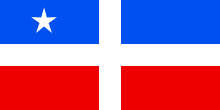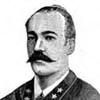Grito de Lares
The Grito de Lares ( German Schrei von Lares ) was a revolt against Spanish rule in Puerto Rico , which occurred on September 23, 1868 in Lares .
prehistory
Mid-19th century were in Puerto Rico many advocates of independence and other people, the liberal reforms demanded arrested and into exile banished. Puerto Rico suffered a severe economic crisis at the time, as mercantilist Spain increased tariffs and taxes on most imported and exported goods. The Spaniards needed this money to finance their troops fighting to recapture the Dominican Republic . Out of frustration at the lack of political and economic freedom and anger at the ongoing oppression on the island, the independence movement planned an armed rebellion.
The riot
planning phase
The Grito de Lares took place on September 23, 1868, but has long been held by a group around Dr. Ramón Emeterio Betances and Segundo Ruiz Belvis planned, who founded the revolutionary committee Comité Revolucionario de Puerto Rico on January 6, 1868 from their exile in the Dominican Republic . Betances penned some commentaries ( proclamas ) in which he denounced the exploitation of Puerto Ricans by the Spanish colonial system and called for an immediate uprising. These statements soon spread across the island, whereupon local dissident groups organized. In the same year, the poet Lola Rodríguez de Tió wrote the patriotic text for the existing melody of La Borinqueña - inspired by Betances' striving for the independence of Puerto Rico . Mathias Brugman , Mariana Bracetti and Manuel Rojas set up secret cells of the revolutionary committee in which they brought together members from all walks of life - landowners, merchants, businessmen, farmers and slaves. Most of them were born on the island ( criollos ). The critical economic situation, together with the increasing repression by the Spaniards, served as a catalyst for the rebellion. The towns in the mountains in the west of the island served as a bulwark of movement.
According to the original plan, the uprising in Camuy was scheduled to begin on September 29 , but since the Spanish authorities discovered the plan, the rebels had to bring it forward. On the night of September 19, the Spanish captain Juan Castañón overheard two rebels talking about the plan in Quebradillas: On September 29, the force in Camuy was to be neutralized by poisoning the bread supplies. Since September 29 was a public holiday for most workers, simultaneous riots were supposed to take place in Camuy and other places. There should be reinforcements from the ship El Telégrafo and more than 3,000 mercenaries. Castañón warned his commanding officer in Arecibo and the leaders of the Lanzador del Norte cell in Camuy were arrested.
Proclamation of the Republic of Puerto Rico
After the first plan failed, it was agreed to strike in Lares on September 24th. Around 400 to 600 rebels (the Spanish journalist José Perez Morís speaks of almost 1,000) gathered that day in the hacienda of Manuel Rojas near Pezuela on the outskirts of Lares. The poorly trained and armed rebels reached the city on horseback and on foot around midnight. They raided the local shops and offices owned by the native Spanish ( peninsulares ) and captured the town hall. The rebels captured the Spanish traders and local government officials whom they viewed as enemies of the fatherland. Then they invaded the church. There they attached the revolutionary flag woven by Bracetti to the high altar as a symbol of the beginning of the revolution. At two o'clock in the morning, the Republic of Puerto Rico was proclaimed under the presidency of Francisco Ramirez Medina . All slaves who had joined the movement were declared free citizens.
Confrontation in San Sebastiàn
The rebels then set out to conquer the next city, San Sebastián del Pepino . However, the Spanish military surprised the group with strong resistance, which caused great unrest among the armed rebels. Under the leadership of Manuel Rojas, they withdrew to Lares. On the orders of Governor Julián Pavía, the Spaniards surrounded the rebels and quickly ended the uprising.
Condemnation and amnesty
Around 475 rebels were arrested, including Manuel Rojas and Juan Rius Rivera , who later became the chief commander of the Cuban Liberation Army. On November 17, a military court sentenced all prisoners to death for treason and sedition . However, in order to calm the already tense atmosphere on the island, the upcoming governor José Laureano Sanz dictated a general amnesty in 1869 , after which all prisoners were released.
aftermath
Although the revolt itself failed, it had positive results as the Spanish granted the island greater political autonomy.
The Spanish journalist José Pérez Morís wrote an extensive book about the Grito de Lares and its participants, which, despite its negative prejudices, is the most accurate account of the events from a historical perspective. From an ideological point of view, Pérez's publications continue to be used by opponents of independence to denounce what they consider to be an exaggerated glorification of a minor revolt. However, recent studies show that the Grito had more sympathizers - and more extensive logistics - than the duration of the events suggested. In the years after the Grito , there were small protests and skirmishes between independence officials and the Spanish authorities in Las Marías , Adjuntas , Utuado , Vieques , Bayamón , Ciales and Toa Baja (Palo Seco). Historians also see the length of Pérez's comments compared to the actual accounts in his book as a clue. If the revolt were really as insignificant as he claims it would not need such extensive, negative treatment.
Grito de Lares as a holiday
The Grito to celebrate as a holiday was outlawed by the Spanish and American authorities in Puerto Rico at different times. The Spanish ban lasted until 1899, when their colonial rule in Puerto Rico formally ended. Consequently, the fell Grito apart from small anniversaries of the people of Lares largely forgotten. However, advocates of independence such as José de Diego and Luis Lloréns Torres campaigned for a public holiday. Diego, for example, requested the Puerto Rican legislature to establish the University of Puerto Rico at Mayagüez on September 23, 1911, so that this event would take place on the anniversary of the Grito .
At the end of the 1920s, members of the Puerto Rico nationalist party held small memorial services in Lares for historical reasons and to collect donations. When Pedro Albizu Campos took over the chairmanship of the party, he replaced the frivolous activities (such as the annual dance) with rituals that celebrated the event with more dignity. He commented on this as follows: “Lares is the Holy Land and as such one must visit it by kneeling down.” (“Lares es Tierra Santa, y como tal, debe entrarse a ella de rodillas.”)
A tamarind tree from Simón Bolívar's property in Venezuela , which the Chilean writer Gabriela Mistral donated to the Albizu family, played a central role in the rituals . The tree was planted in the Plaza de la Revolución with soil from the eighteen other Spanish-speaking countries in Latin America . Albizu wanted the plaza to be a living symbol of solidarity with the struggle for freedom and independence initiated by Bolívar (who, on a visit to Vieques, promised to help the Puerto Rican independence movement but never got the opportunity due to his own power struggles). The bittersweet fruits of the tree also symbolized the efforts that were necessary to achieve independence. In this regard, there are parallels between the Tamarindo de Don Pedro and the Guernica oak ( Gernikako Arbola ) in the Basque Country .
In 1969 , a supporter of the state and a political poser, Governor Luis A. Ferré declared September 23 a national holiday. Lares has been declared a Historic Site by the Institute for Puerto Rican Culture and is considered the birthplace of Puerto Rican nationalism.
- Leader of the Grito de Lares
Individual evidence
- ↑ José Peres Moris: Historia de la Insurrección de Lares. (pdf, 923 kB) Narciso Ramirez, Barcelona, 1872, accessed on September 23, 2018 (Spanish, archived at the Library of Congress).
- ^ Francisco Moscoso: La Revolución Puertorriqueña de 1868: El Grito de Lares . Instituto de Cultura Puertorriqueña, 2003.
- ↑ Francisco Moscoso quoted in: Ángel Collado Schwarz: Voces de la Cultura . Fundación La Voz del Centro, San Juan, 2005.






